DE200: Experimental Mini Project Report on Change Blindness Study
VerifiedAdded on 2023/06/14
|9
|2618
|65
Report
AI Summary
This experimental mini-project report investigates change blindness, examining reaction times to congruent, category change, and incongruent images. A quantitative study using ANOVA was conducted with 250 participants from a DE200 course. The results indicated no statistically significant difference in reaction times across the image types, leading to the acceptance of the null hypothesis. The discussion explores potential reasons for this finding, including limitations related to sample size and age range. The report references previous research on change blindness, attention, and individual differences in visual processing, highlighting the complexity of detecting changes in visual stimuli. Desklib provides solved assignments and past papers for students.

Experimental mini project report
Paraphrase This Document
Need a fresh take? Get an instant paraphrase of this document with our AI Paraphraser

TABLE OF CONTENTS
ABSTRACT....................................................................................................................................3
INTRODUCTION...........................................................................................................................4
Methods.......................................................................................................................................5
Results..........................................................................................................................................6
Discussion....................................................................................................................................7
REFERENCES................................................................................................................................9
ABSTRACT....................................................................................................................................3
INTRODUCTION...........................................................................................................................4
Methods.......................................................................................................................................5
Results..........................................................................................................................................6
Discussion....................................................................................................................................7
REFERENCES................................................................................................................................9
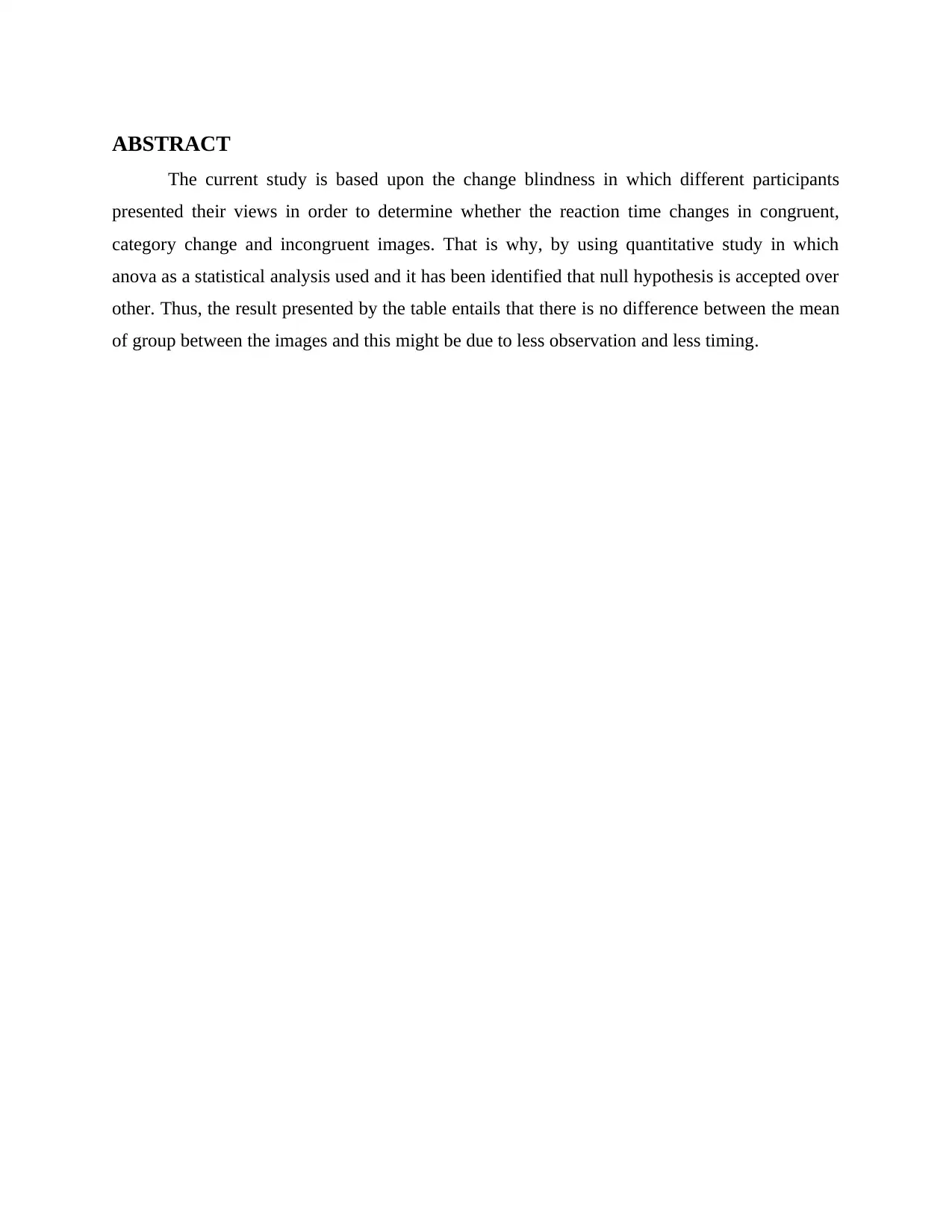
ABSTRACT
The current study is based upon the change blindness in which different participants
presented their views in order to determine whether the reaction time changes in congruent,
category change and incongruent images. That is why, by using quantitative study in which
anova as a statistical analysis used and it has been identified that null hypothesis is accepted over
other. Thus, the result presented by the table entails that there is no difference between the mean
of group between the images and this might be due to less observation and less timing.
The current study is based upon the change blindness in which different participants
presented their views in order to determine whether the reaction time changes in congruent,
category change and incongruent images. That is why, by using quantitative study in which
anova as a statistical analysis used and it has been identified that null hypothesis is accepted over
other. Thus, the result presented by the table entails that there is no difference between the mean
of group between the images and this might be due to less observation and less timing.
⊘ This is a preview!⊘
Do you want full access?
Subscribe today to unlock all pages.

Trusted by 1+ million students worldwide
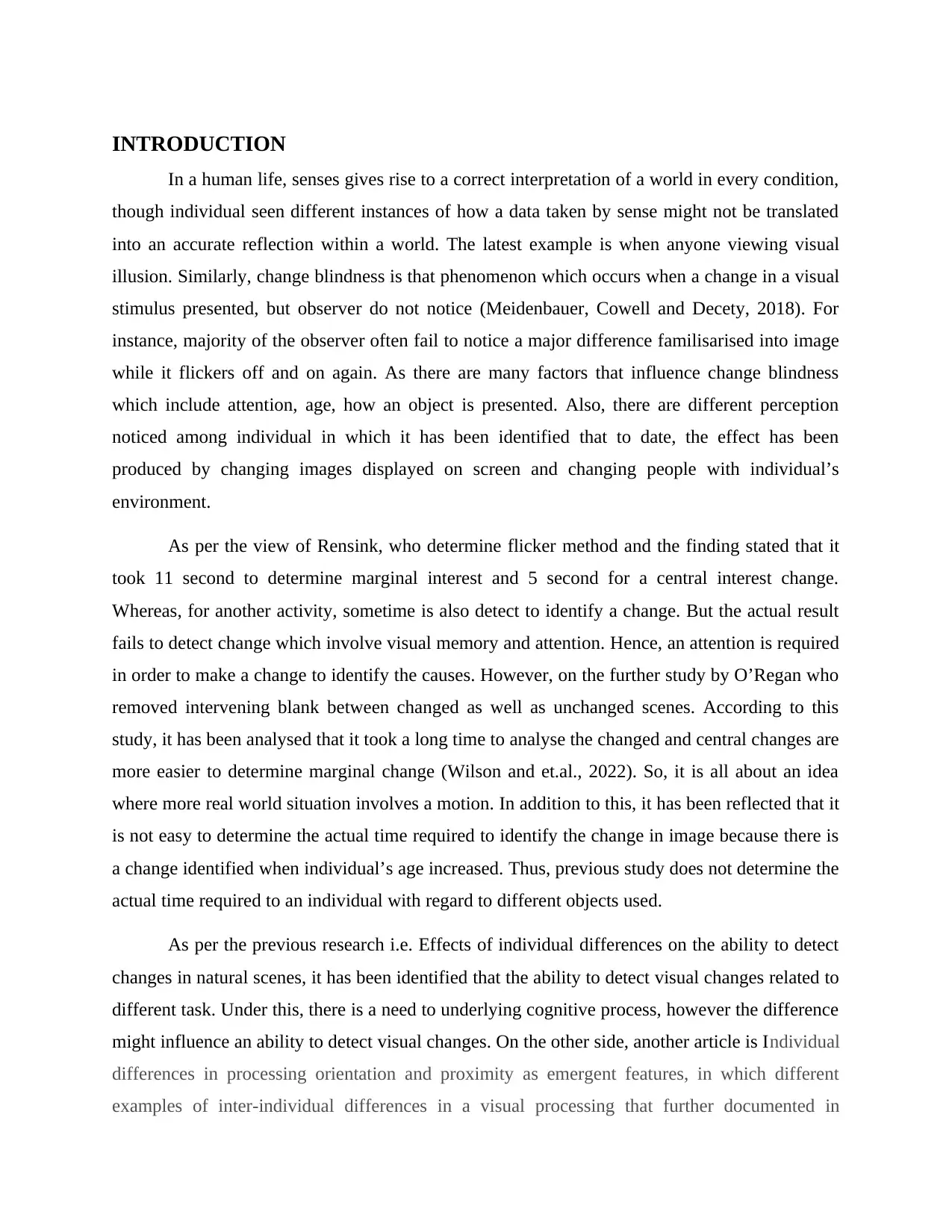
INTRODUCTION
In a human life, senses gives rise to a correct interpretation of a world in every condition,
though individual seen different instances of how a data taken by sense might not be translated
into an accurate reflection within a world. The latest example is when anyone viewing visual
illusion. Similarly, change blindness is that phenomenon which occurs when a change in a visual
stimulus presented, but observer do not notice (Meidenbauer, Cowell and Decety, 2018). For
instance, majority of the observer often fail to notice a major difference familisarised into image
while it flickers off and on again. As there are many factors that influence change blindness
which include attention, age, how an object is presented. Also, there are different perception
noticed among individual in which it has been identified that to date, the effect has been
produced by changing images displayed on screen and changing people with individual’s
environment.
As per the view of Rensink, who determine flicker method and the finding stated that it
took 11 second to determine marginal interest and 5 second for a central interest change.
Whereas, for another activity, sometime is also detect to identify a change. But the actual result
fails to detect change which involve visual memory and attention. Hence, an attention is required
in order to make a change to identify the causes. However, on the further study by O’Regan who
removed intervening blank between changed as well as unchanged scenes. According to this
study, it has been analysed that it took a long time to analyse the changed and central changes are
more easier to determine marginal change (Wilson and et.al., 2022). So, it is all about an idea
where more real world situation involves a motion. In addition to this, it has been reflected that it
is not easy to determine the actual time required to identify the change in image because there is
a change identified when individual’s age increased. Thus, previous study does not determine the
actual time required to an individual with regard to different objects used.
As per the previous research i.e. Effects of individual differences on the ability to detect
changes in natural scenes, it has been identified that the ability to detect visual changes related to
different task. Under this, there is a need to underlying cognitive process, however the difference
might influence an ability to detect visual changes. On the other side, another article is Individual
differences in processing orientation and proximity as emergent features, in which different
examples of inter-individual differences in a visual processing that further documented in
In a human life, senses gives rise to a correct interpretation of a world in every condition,
though individual seen different instances of how a data taken by sense might not be translated
into an accurate reflection within a world. The latest example is when anyone viewing visual
illusion. Similarly, change blindness is that phenomenon which occurs when a change in a visual
stimulus presented, but observer do not notice (Meidenbauer, Cowell and Decety, 2018). For
instance, majority of the observer often fail to notice a major difference familisarised into image
while it flickers off and on again. As there are many factors that influence change blindness
which include attention, age, how an object is presented. Also, there are different perception
noticed among individual in which it has been identified that to date, the effect has been
produced by changing images displayed on screen and changing people with individual’s
environment.
As per the view of Rensink, who determine flicker method and the finding stated that it
took 11 second to determine marginal interest and 5 second for a central interest change.
Whereas, for another activity, sometime is also detect to identify a change. But the actual result
fails to detect change which involve visual memory and attention. Hence, an attention is required
in order to make a change to identify the causes. However, on the further study by O’Regan who
removed intervening blank between changed as well as unchanged scenes. According to this
study, it has been analysed that it took a long time to analyse the changed and central changes are
more easier to determine marginal change (Wilson and et.al., 2022). So, it is all about an idea
where more real world situation involves a motion. In addition to this, it has been reflected that it
is not easy to determine the actual time required to identify the change in image because there is
a change identified when individual’s age increased. Thus, previous study does not determine the
actual time required to an individual with regard to different objects used.
As per the previous research i.e. Effects of individual differences on the ability to detect
changes in natural scenes, it has been identified that the ability to detect visual changes related to
different task. Under this, there is a need to underlying cognitive process, however the difference
might influence an ability to detect visual changes. On the other side, another article is Individual
differences in processing orientation and proximity as emergent features, in which different
examples of inter-individual differences in a visual processing that further documented in
Paraphrase This Document
Need a fresh take? Get an instant paraphrase of this document with our AI Paraphraser
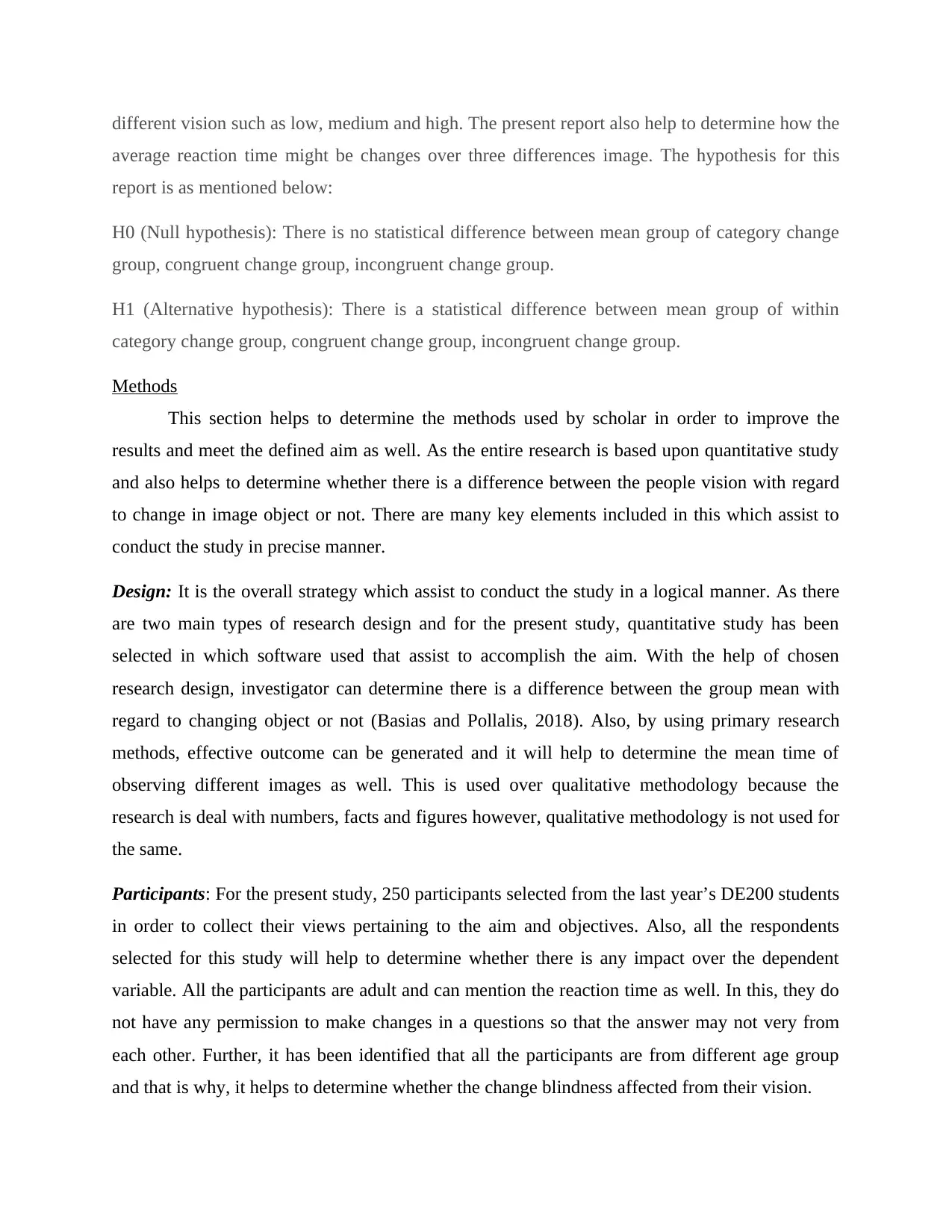
different vision such as low, medium and high. The present report also help to determine how the
average reaction time might be changes over three differences image. The hypothesis for this
report is as mentioned below:
H0 (Null hypothesis): There is no statistical difference between mean group of category change
group, congruent change group, incongruent change group.
H1 (Alternative hypothesis): There is a statistical difference between mean group of within
category change group, congruent change group, incongruent change group.
Methods
This section helps to determine the methods used by scholar in order to improve the
results and meet the defined aim as well. As the entire research is based upon quantitative study
and also helps to determine whether there is a difference between the people vision with regard
to change in image object or not. There are many key elements included in this which assist to
conduct the study in precise manner.
Design: It is the overall strategy which assist to conduct the study in a logical manner. As there
are two main types of research design and for the present study, quantitative study has been
selected in which software used that assist to accomplish the aim. With the help of chosen
research design, investigator can determine there is a difference between the group mean with
regard to changing object or not (Basias and Pollalis, 2018). Also, by using primary research
methods, effective outcome can be generated and it will help to determine the mean time of
observing different images as well. This is used over qualitative methodology because the
research is deal with numbers, facts and figures however, qualitative methodology is not used for
the same.
Participants: For the present study, 250 participants selected from the last year’s DE200 students
in order to collect their views pertaining to the aim and objectives. Also, all the respondents
selected for this study will help to determine whether there is any impact over the dependent
variable. All the participants are adult and can mention the reaction time as well. In this, they do
not have any permission to make changes in a questions so that the answer may not very from
each other. Further, it has been identified that all the participants are from different age group
and that is why, it helps to determine whether the change blindness affected from their vision.
average reaction time might be changes over three differences image. The hypothesis for this
report is as mentioned below:
H0 (Null hypothesis): There is no statistical difference between mean group of category change
group, congruent change group, incongruent change group.
H1 (Alternative hypothesis): There is a statistical difference between mean group of within
category change group, congruent change group, incongruent change group.
Methods
This section helps to determine the methods used by scholar in order to improve the
results and meet the defined aim as well. As the entire research is based upon quantitative study
and also helps to determine whether there is a difference between the people vision with regard
to change in image object or not. There are many key elements included in this which assist to
conduct the study in precise manner.
Design: It is the overall strategy which assist to conduct the study in a logical manner. As there
are two main types of research design and for the present study, quantitative study has been
selected in which software used that assist to accomplish the aim. With the help of chosen
research design, investigator can determine there is a difference between the group mean with
regard to changing object or not (Basias and Pollalis, 2018). Also, by using primary research
methods, effective outcome can be generated and it will help to determine the mean time of
observing different images as well. This is used over qualitative methodology because the
research is deal with numbers, facts and figures however, qualitative methodology is not used for
the same.
Participants: For the present study, 250 participants selected from the last year’s DE200 students
in order to collect their views pertaining to the aim and objectives. Also, all the respondents
selected for this study will help to determine whether there is any impact over the dependent
variable. All the participants are adult and can mention the reaction time as well. In this, they do
not have any permission to make changes in a questions so that the answer may not very from
each other. Further, it has been identified that all the participants are from different age group
and that is why, it helps to determine whether the change blindness affected from their vision.
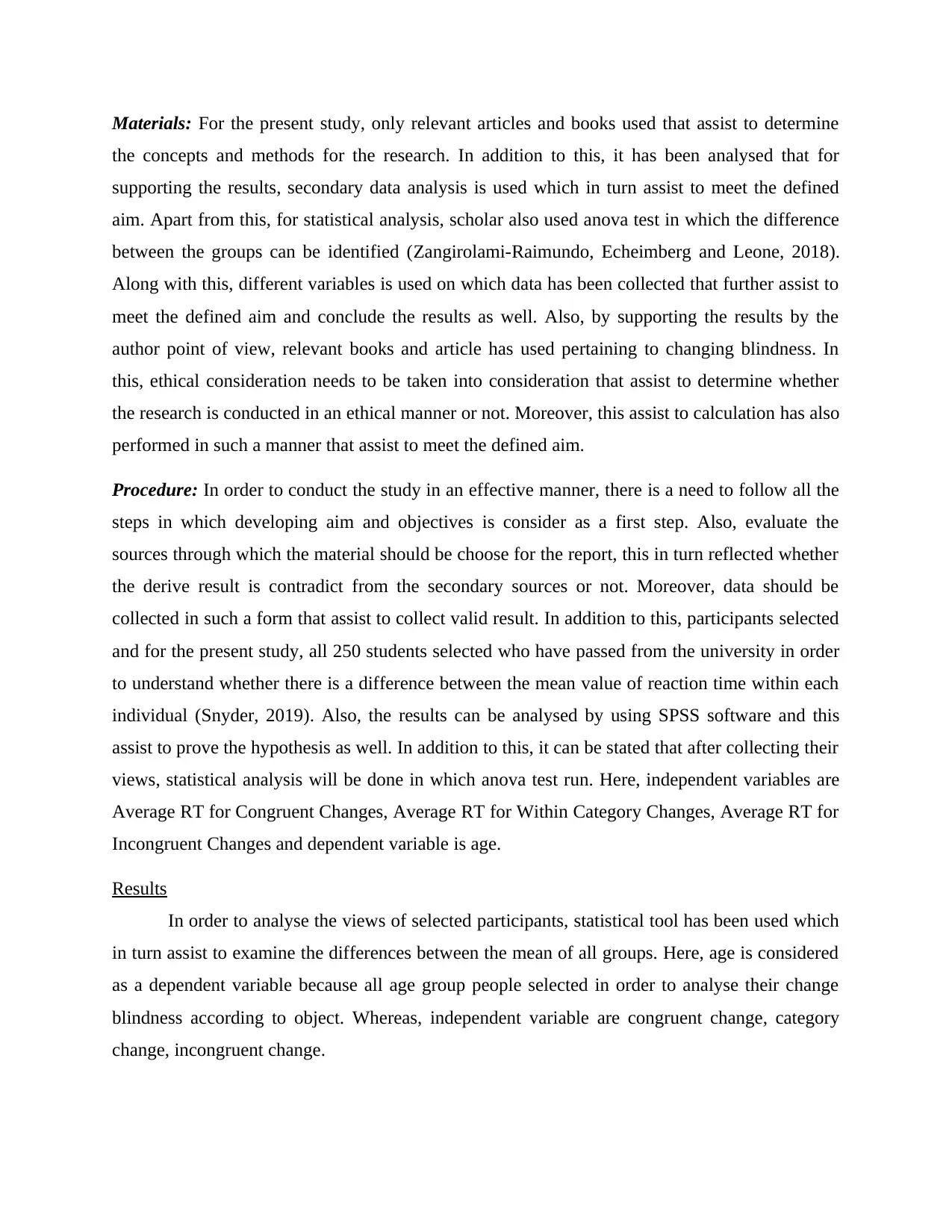
Materials: For the present study, only relevant articles and books used that assist to determine
the concepts and methods for the research. In addition to this, it has been analysed that for
supporting the results, secondary data analysis is used which in turn assist to meet the defined
aim. Apart from this, for statistical analysis, scholar also used anova test in which the difference
between the groups can be identified (Zangirolami-Raimundo, Echeimberg and Leone, 2018).
Along with this, different variables is used on which data has been collected that further assist to
meet the defined aim and conclude the results as well. Also, by supporting the results by the
author point of view, relevant books and article has used pertaining to changing blindness. In
this, ethical consideration needs to be taken into consideration that assist to determine whether
the research is conducted in an ethical manner or not. Moreover, this assist to calculation has also
performed in such a manner that assist to meet the defined aim.
Procedure: In order to conduct the study in an effective manner, there is a need to follow all the
steps in which developing aim and objectives is consider as a first step. Also, evaluate the
sources through which the material should be choose for the report, this in turn reflected whether
the derive result is contradict from the secondary sources or not. Moreover, data should be
collected in such a form that assist to collect valid result. In addition to this, participants selected
and for the present study, all 250 students selected who have passed from the university in order
to understand whether there is a difference between the mean value of reaction time within each
individual (Snyder, 2019). Also, the results can be analysed by using SPSS software and this
assist to prove the hypothesis as well. In addition to this, it can be stated that after collecting their
views, statistical analysis will be done in which anova test run. Here, independent variables are
Average RT for Congruent Changes, Average RT for Within Category Changes, Average RT for
Incongruent Changes and dependent variable is age.
Results
In order to analyse the views of selected participants, statistical tool has been used which
in turn assist to examine the differences between the mean of all groups. Here, age is considered
as a dependent variable because all age group people selected in order to analyse their change
blindness according to object. Whereas, independent variable are congruent change, category
change, incongruent change.
the concepts and methods for the research. In addition to this, it has been analysed that for
supporting the results, secondary data analysis is used which in turn assist to meet the defined
aim. Apart from this, for statistical analysis, scholar also used anova test in which the difference
between the groups can be identified (Zangirolami-Raimundo, Echeimberg and Leone, 2018).
Along with this, different variables is used on which data has been collected that further assist to
meet the defined aim and conclude the results as well. Also, by supporting the results by the
author point of view, relevant books and article has used pertaining to changing blindness. In
this, ethical consideration needs to be taken into consideration that assist to determine whether
the research is conducted in an ethical manner or not. Moreover, this assist to calculation has also
performed in such a manner that assist to meet the defined aim.
Procedure: In order to conduct the study in an effective manner, there is a need to follow all the
steps in which developing aim and objectives is consider as a first step. Also, evaluate the
sources through which the material should be choose for the report, this in turn reflected whether
the derive result is contradict from the secondary sources or not. Moreover, data should be
collected in such a form that assist to collect valid result. In addition to this, participants selected
and for the present study, all 250 students selected who have passed from the university in order
to understand whether there is a difference between the mean value of reaction time within each
individual (Snyder, 2019). Also, the results can be analysed by using SPSS software and this
assist to prove the hypothesis as well. In addition to this, it can be stated that after collecting their
views, statistical analysis will be done in which anova test run. Here, independent variables are
Average RT for Congruent Changes, Average RT for Within Category Changes, Average RT for
Incongruent Changes and dependent variable is age.
Results
In order to analyse the views of selected participants, statistical tool has been used which
in turn assist to examine the differences between the mean of all groups. Here, age is considered
as a dependent variable because all age group people selected in order to analyse their change
blindness according to object. Whereas, independent variable are congruent change, category
change, incongruent change.
⊘ This is a preview!⊘
Do you want full access?
Subscribe today to unlock all pages.

Trusted by 1+ million students worldwide
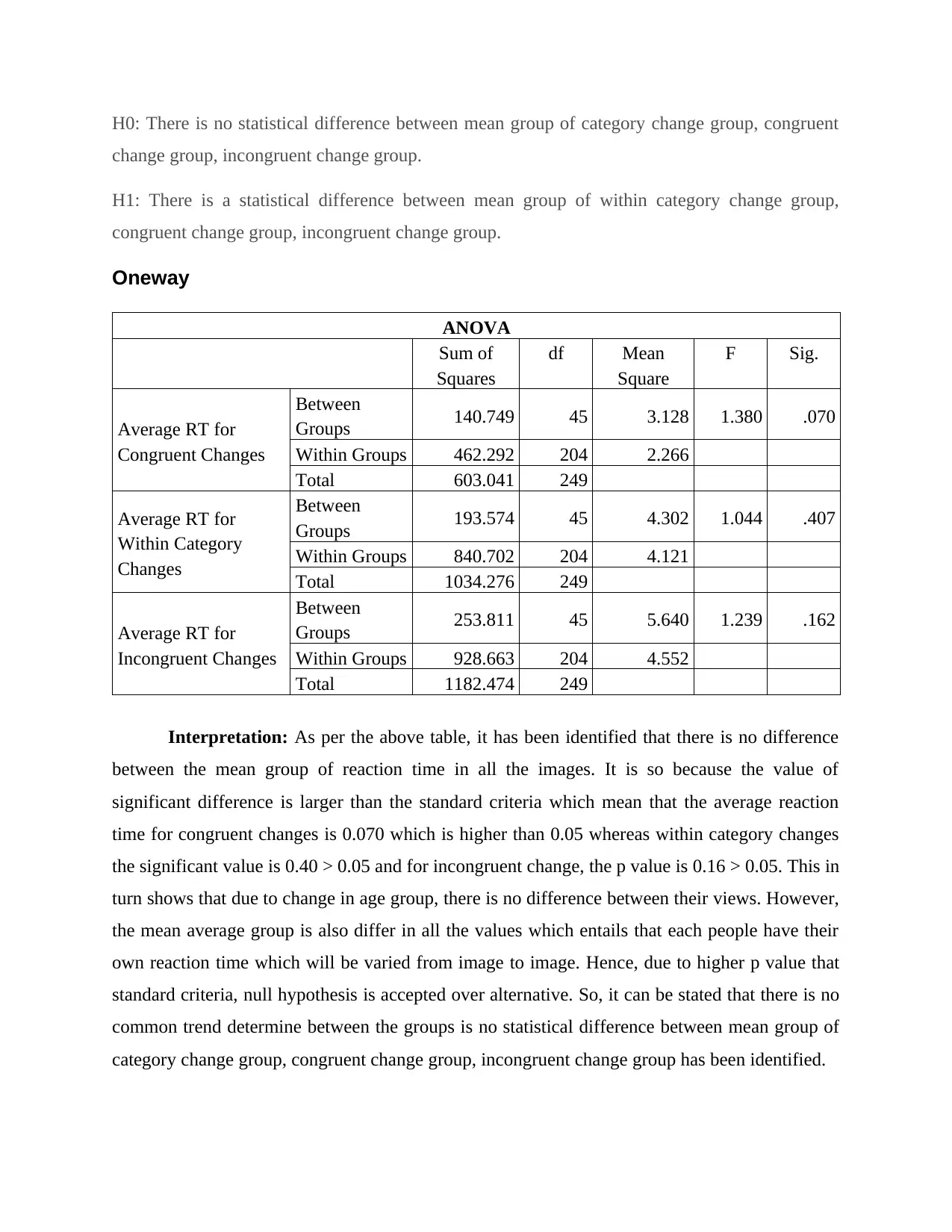
H0: There is no statistical difference between mean group of category change group, congruent
change group, incongruent change group.
H1: There is a statistical difference between mean group of within category change group,
congruent change group, incongruent change group.
Oneway
ANOVA
Sum of
Squares
df Mean
Square
F Sig.
Average RT for
Congruent Changes
Between
Groups 140.749 45 3.128 1.380 .070
Within Groups 462.292 204 2.266
Total 603.041 249
Average RT for
Within Category
Changes
Between
Groups 193.574 45 4.302 1.044 .407
Within Groups 840.702 204 4.121
Total 1034.276 249
Average RT for
Incongruent Changes
Between
Groups 253.811 45 5.640 1.239 .162
Within Groups 928.663 204 4.552
Total 1182.474 249
Interpretation: As per the above table, it has been identified that there is no difference
between the mean group of reaction time in all the images. It is so because the value of
significant difference is larger than the standard criteria which mean that the average reaction
time for congruent changes is 0.070 which is higher than 0.05 whereas within category changes
the significant value is 0.40 > 0.05 and for incongruent change, the p value is 0.16 > 0.05. This in
turn shows that due to change in age group, there is no difference between their views. However,
the mean average group is also differ in all the values which entails that each people have their
own reaction time which will be varied from image to image. Hence, due to higher p value that
standard criteria, null hypothesis is accepted over alternative. So, it can be stated that there is no
common trend determine between the groups is no statistical difference between mean group of
category change group, congruent change group, incongruent change group has been identified.
change group, incongruent change group.
H1: There is a statistical difference between mean group of within category change group,
congruent change group, incongruent change group.
Oneway
ANOVA
Sum of
Squares
df Mean
Square
F Sig.
Average RT for
Congruent Changes
Between
Groups 140.749 45 3.128 1.380 .070
Within Groups 462.292 204 2.266
Total 603.041 249
Average RT for
Within Category
Changes
Between
Groups 193.574 45 4.302 1.044 .407
Within Groups 840.702 204 4.121
Total 1034.276 249
Average RT for
Incongruent Changes
Between
Groups 253.811 45 5.640 1.239 .162
Within Groups 928.663 204 4.552
Total 1182.474 249
Interpretation: As per the above table, it has been identified that there is no difference
between the mean group of reaction time in all the images. It is so because the value of
significant difference is larger than the standard criteria which mean that the average reaction
time for congruent changes is 0.070 which is higher than 0.05 whereas within category changes
the significant value is 0.40 > 0.05 and for incongruent change, the p value is 0.16 > 0.05. This in
turn shows that due to change in age group, there is no difference between their views. However,
the mean average group is also differ in all the values which entails that each people have their
own reaction time which will be varied from image to image. Hence, due to higher p value that
standard criteria, null hypothesis is accepted over alternative. So, it can be stated that there is no
common trend determine between the groups is no statistical difference between mean group of
category change group, congruent change group, incongruent change group has been identified.
Paraphrase This Document
Need a fresh take? Get an instant paraphrase of this document with our AI Paraphraser
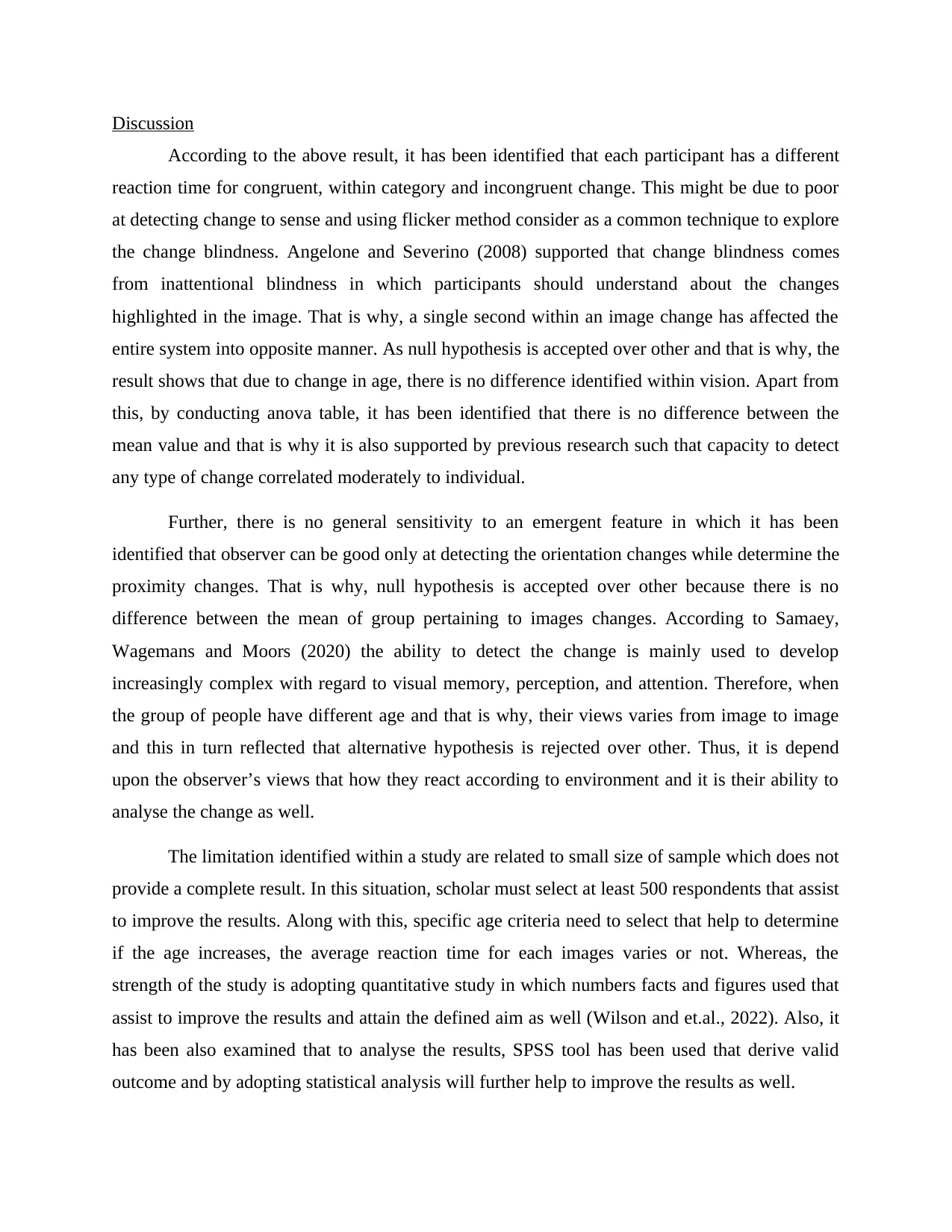
Discussion
According to the above result, it has been identified that each participant has a different
reaction time for congruent, within category and incongruent change. This might be due to poor
at detecting change to sense and using flicker method consider as a common technique to explore
the change blindness. Angelone and Severino (2008) supported that change blindness comes
from inattentional blindness in which participants should understand about the changes
highlighted in the image. That is why, a single second within an image change has affected the
entire system into opposite manner. As null hypothesis is accepted over other and that is why, the
result shows that due to change in age, there is no difference identified within vision. Apart from
this, by conducting anova table, it has been identified that there is no difference between the
mean value and that is why it is also supported by previous research such that capacity to detect
any type of change correlated moderately to individual.
Further, there is no general sensitivity to an emergent feature in which it has been
identified that observer can be good only at detecting the orientation changes while determine the
proximity changes. That is why, null hypothesis is accepted over other because there is no
difference between the mean of group pertaining to images changes. According to Samaey,
Wagemans and Moors (2020) the ability to detect the change is mainly used to develop
increasingly complex with regard to visual memory, perception, and attention. Therefore, when
the group of people have different age and that is why, their views varies from image to image
and this in turn reflected that alternative hypothesis is rejected over other. Thus, it is depend
upon the observer’s views that how they react according to environment and it is their ability to
analyse the change as well.
The limitation identified within a study are related to small size of sample which does not
provide a complete result. In this situation, scholar must select at least 500 respondents that assist
to improve the results. Along with this, specific age criteria need to select that help to determine
if the age increases, the average reaction time for each images varies or not. Whereas, the
strength of the study is adopting quantitative study in which numbers facts and figures used that
assist to improve the results and attain the defined aim as well (Wilson and et.al., 2022). Also, it
has been also examined that to analyse the results, SPSS tool has been used that derive valid
outcome and by adopting statistical analysis will further help to improve the results as well.
According to the above result, it has been identified that each participant has a different
reaction time for congruent, within category and incongruent change. This might be due to poor
at detecting change to sense and using flicker method consider as a common technique to explore
the change blindness. Angelone and Severino (2008) supported that change blindness comes
from inattentional blindness in which participants should understand about the changes
highlighted in the image. That is why, a single second within an image change has affected the
entire system into opposite manner. As null hypothesis is accepted over other and that is why, the
result shows that due to change in age, there is no difference identified within vision. Apart from
this, by conducting anova table, it has been identified that there is no difference between the
mean value and that is why it is also supported by previous research such that capacity to detect
any type of change correlated moderately to individual.
Further, there is no general sensitivity to an emergent feature in which it has been
identified that observer can be good only at detecting the orientation changes while determine the
proximity changes. That is why, null hypothesis is accepted over other because there is no
difference between the mean of group pertaining to images changes. According to Samaey,
Wagemans and Moors (2020) the ability to detect the change is mainly used to develop
increasingly complex with regard to visual memory, perception, and attention. Therefore, when
the group of people have different age and that is why, their views varies from image to image
and this in turn reflected that alternative hypothesis is rejected over other. Thus, it is depend
upon the observer’s views that how they react according to environment and it is their ability to
analyse the change as well.
The limitation identified within a study are related to small size of sample which does not
provide a complete result. In this situation, scholar must select at least 500 respondents that assist
to improve the results. Along with this, specific age criteria need to select that help to determine
if the age increases, the average reaction time for each images varies or not. Whereas, the
strength of the study is adopting quantitative study in which numbers facts and figures used that
assist to improve the results and attain the defined aim as well (Wilson and et.al., 2022). Also, it
has been also examined that to analyse the results, SPSS tool has been used that derive valid
outcome and by adopting statistical analysis will further help to improve the results as well.
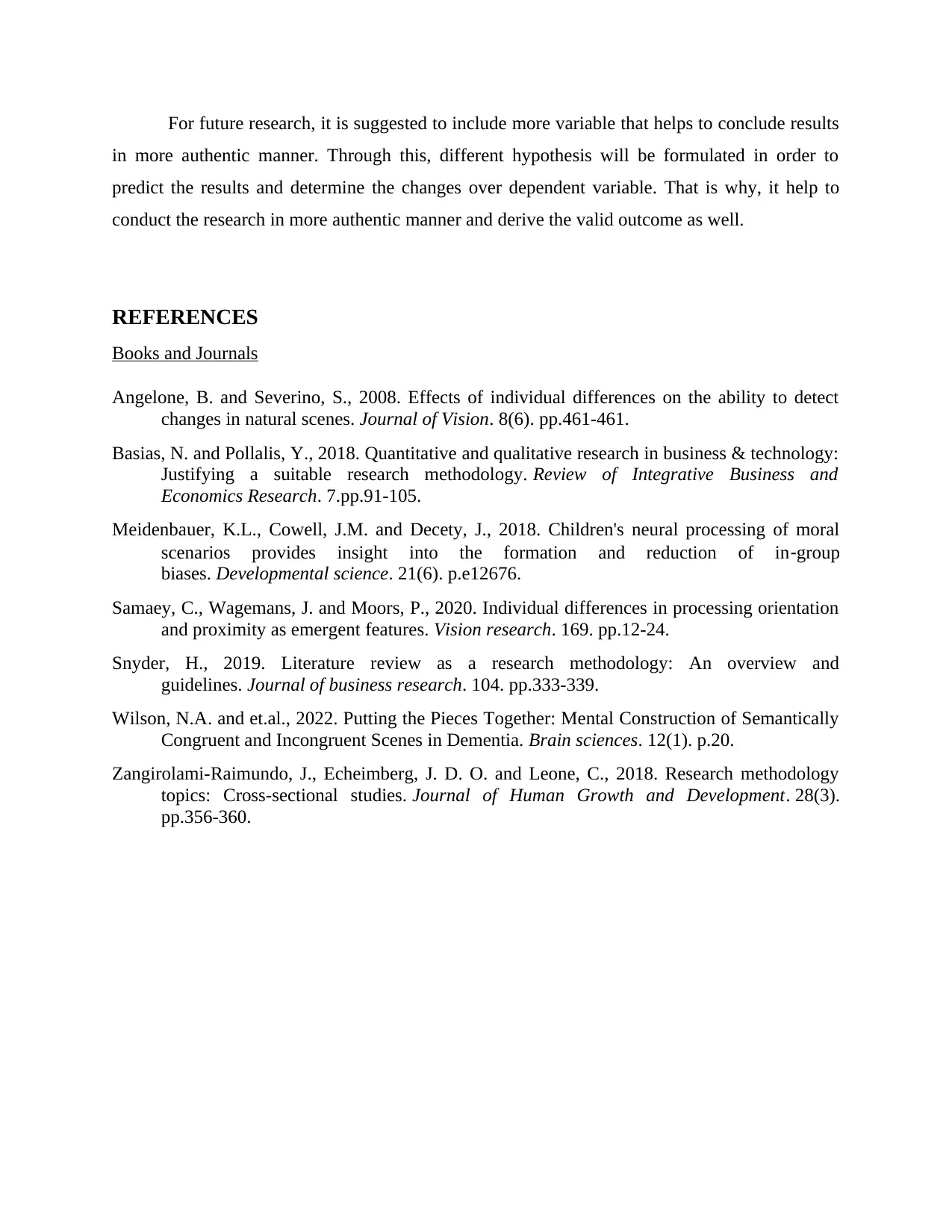
For future research, it is suggested to include more variable that helps to conclude results
in more authentic manner. Through this, different hypothesis will be formulated in order to
predict the results and determine the changes over dependent variable. That is why, it help to
conduct the research in more authentic manner and derive the valid outcome as well.
REFERENCES
Books and Journals
Angelone, B. and Severino, S., 2008. Effects of individual differences on the ability to detect
changes in natural scenes. Journal of Vision. 8(6). pp.461-461.
Basias, N. and Pollalis, Y., 2018. Quantitative and qualitative research in business & technology:
Justifying a suitable research methodology. Review of Integrative Business and
Economics Research. 7.pp.91-105.
Meidenbauer, K.L., Cowell, J.M. and Decety, J., 2018. Children's neural processing of moral
scenarios provides insight into the formation and reduction of in‐group
biases. Developmental science. 21(6). p.e12676.
Samaey, C., Wagemans, J. and Moors, P., 2020. Individual differences in processing orientation
and proximity as emergent features. Vision research. 169. pp.12-24.
Snyder, H., 2019. Literature review as a research methodology: An overview and
guidelines. Journal of business research. 104. pp.333-339.
Wilson, N.A. and et.al., 2022. Putting the Pieces Together: Mental Construction of Semantically
Congruent and Incongruent Scenes in Dementia. Brain sciences. 12(1). p.20.
Zangirolami-Raimundo, J., Echeimberg, J. D. O. and Leone, C., 2018. Research methodology
topics: Cross-sectional studies. Journal of Human Growth and Development. 28(3).
pp.356-360.
in more authentic manner. Through this, different hypothesis will be formulated in order to
predict the results and determine the changes over dependent variable. That is why, it help to
conduct the research in more authentic manner and derive the valid outcome as well.
REFERENCES
Books and Journals
Angelone, B. and Severino, S., 2008. Effects of individual differences on the ability to detect
changes in natural scenes. Journal of Vision. 8(6). pp.461-461.
Basias, N. and Pollalis, Y., 2018. Quantitative and qualitative research in business & technology:
Justifying a suitable research methodology. Review of Integrative Business and
Economics Research. 7.pp.91-105.
Meidenbauer, K.L., Cowell, J.M. and Decety, J., 2018. Children's neural processing of moral
scenarios provides insight into the formation and reduction of in‐group
biases. Developmental science. 21(6). p.e12676.
Samaey, C., Wagemans, J. and Moors, P., 2020. Individual differences in processing orientation
and proximity as emergent features. Vision research. 169. pp.12-24.
Snyder, H., 2019. Literature review as a research methodology: An overview and
guidelines. Journal of business research. 104. pp.333-339.
Wilson, N.A. and et.al., 2022. Putting the Pieces Together: Mental Construction of Semantically
Congruent and Incongruent Scenes in Dementia. Brain sciences. 12(1). p.20.
Zangirolami-Raimundo, J., Echeimberg, J. D. O. and Leone, C., 2018. Research methodology
topics: Cross-sectional studies. Journal of Human Growth and Development. 28(3).
pp.356-360.
⊘ This is a preview!⊘
Do you want full access?
Subscribe today to unlock all pages.

Trusted by 1+ million students worldwide
1 out of 9
Related Documents
Your All-in-One AI-Powered Toolkit for Academic Success.
+13062052269
info@desklib.com
Available 24*7 on WhatsApp / Email
![[object Object]](/_next/static/media/star-bottom.7253800d.svg)
Unlock your academic potential
Copyright © 2020–2025 A2Z Services. All Rights Reserved. Developed and managed by ZUCOL.





